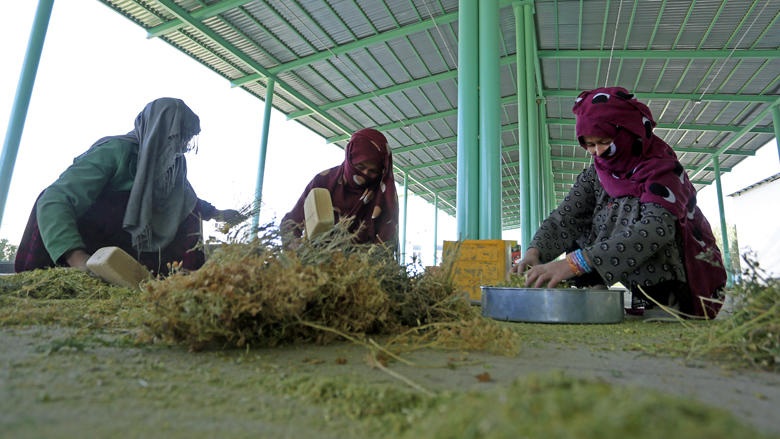
Story Highlights
- A research farm in Bamyan province is benefiting farmers by developing seeds that are adapted to local conditions.
- Afghanistan Research Farm (name changed) is one of 11 regional research farms across the country supported by the Afghanistan Agricultural Inputs Project.
- The project, supported by the Afghanistan Reconstruction Trust Fund, aims to increase adoption of improved crop production technologies in the agricultural sector, which is central to Afghanistan’s economy.
BAMYAN CITY, Bamyan Province – Breakthroughs at the Afghanistan Research Farm (name changed) in Bamyan city have produced seeds adapted to the local climate and resistant to diseases. The improved seeds are contributing to better harvests.
Afghanistan Research Farm has operated for seven years. Its research on soybeans and potatoes has been its crowning achievement, according to the farm’s grain research director.
“Without research,” he says, “we cannot introduce good seeds to farmers and we want the farmers to have good products.” The work on soybeans, potatoes, and wheat at the Afghanistan Research Farm is vital. The majority of rural Afghans depend on agriculture, and research is key to improving agricultural outcomes.
The research on soybean took three years and resulted in seed varieties that are adapted to local conditions. “The soybean research on soil and climate is completed,” says the Research Director for Soybeans. “Two of the soybean varieties created are a perfect match for the soil and climate in Bamyan.”
He explains the importance of this breakthrough for local farmers. Until now, the majority of farmers in Bamyan and neighboring Daikundi province had used seeds that were developed by research farms in other regions, which were not compatible with the central highland climate and conditions.
“These seeds were not successful,” he says. The seeds resulted in poor harvests and a high risk of disease. “The main goal is to develop improved seeds for farmers to increase production and reduce the risk of disease infection,” he says, of their work at Afghanistan Research Farm.
"Without research, we cannot introduce good seeds to farmers and we want the farmers to have good products."
- Grain Research Director, Mullah Ghulam Research Farm
Seeds Developed for Specific Climates
In 2015, the Ministry of Agriculture, Irrigation and Livestock (MAIL) divided the country into different climate zones to produce seeds specific to each zone. “This approach highly increases the compatibility of seeds with their host climate,” the Research Director says. “If you observe the farms along the road to Daikundi, the [new] improved seeds have been very effective for the farmers.”
Afghanistan Research Farm is one of 11 regional research farms across the country supported by the Afghanistan Agricultural Inputs Project (AAIP), implemented by MAIL. The projects aim was to increase adoption of improved crop production technologies in the agricultural sector.
Closed in June 2019, AAIP was providing technical support to MAIL staff to improve the effectiveness and efficiency of research farms, like Afghanistan Research Farm, through capacity building as well as infrastructural upgrades. It is supported by the Afghanistan Reconstruction Trust Fund (ARTF), administered by the World Bank on behalf of 34 donors.
Increase in Harvests
The breakthrough on potatoes at Afghanistan Research Farm yielded a disease resistant variety that has boosted output. “We have introduced a modified disease resistant potato to local farmers,” Grain Research Director says. “Previously, farmers could harvest 3,500 kg of potatoes from 2,000 m2 of land. With the new modification, they have been able to harvest 7,000 kg from 2,000 m2.” As a result, farmers in Bamyan have adopted the potato as a new crop faster than any other crop, according to him.
Safar Ali (name changed), 55, a local farmer, confirms that the modified disease resistant potato variety has helped increase his harvest, “Before, we harvested 3,500 kg of potatoes [from 2,000 m2]”, he says, “now we can harvest about 5,600 kg.”
Another critical component in AAIP is to strengthen the technical and economic efficiency of the value chain of certified wheat seeds. As the Grain Research Director walks through a small plot of wheat plucking a few specimens to examine, he takes his time rolling each grain in his hand, separating the husk from the grain.
Soon it will be time to harvest and one of his responsibilities is to examine the wheat and oat plants to evaluate the success of the modified seed or new farming method being tested. The varieties that perform well against a set of indicators will be sent to another facility for mass production before being distributed to local farmers in Bamyan province.
Research on wheat is continuing to address the diseases that local farmers complain are infecting their wheat. Due to the spread of disease, many farmers are harvesting just 140 kg of wheat from 7 kg of wheat seeds, he says. “But we are trying to improve those results to 420 kg of wheat with enhanced seeds.”
Work on the Afghanistan Research Farm includes teaching farmers modern agricultural methods to maximize the potential of the improved seeds. Farmers are also advised to cultivate their farms in October rather than November and December, because early cultivation will boost their harvest.
Mohammad (name changed), 61, a local farmer, says he is grateful AAIP introduced him to new farming methods and the improved seeds, which have helped him triple his output on his 4,000 m2 farm. “We could only harvest 160 kg of wheat on our land before, but now our harvest is 480 kg of wheat,” he says.